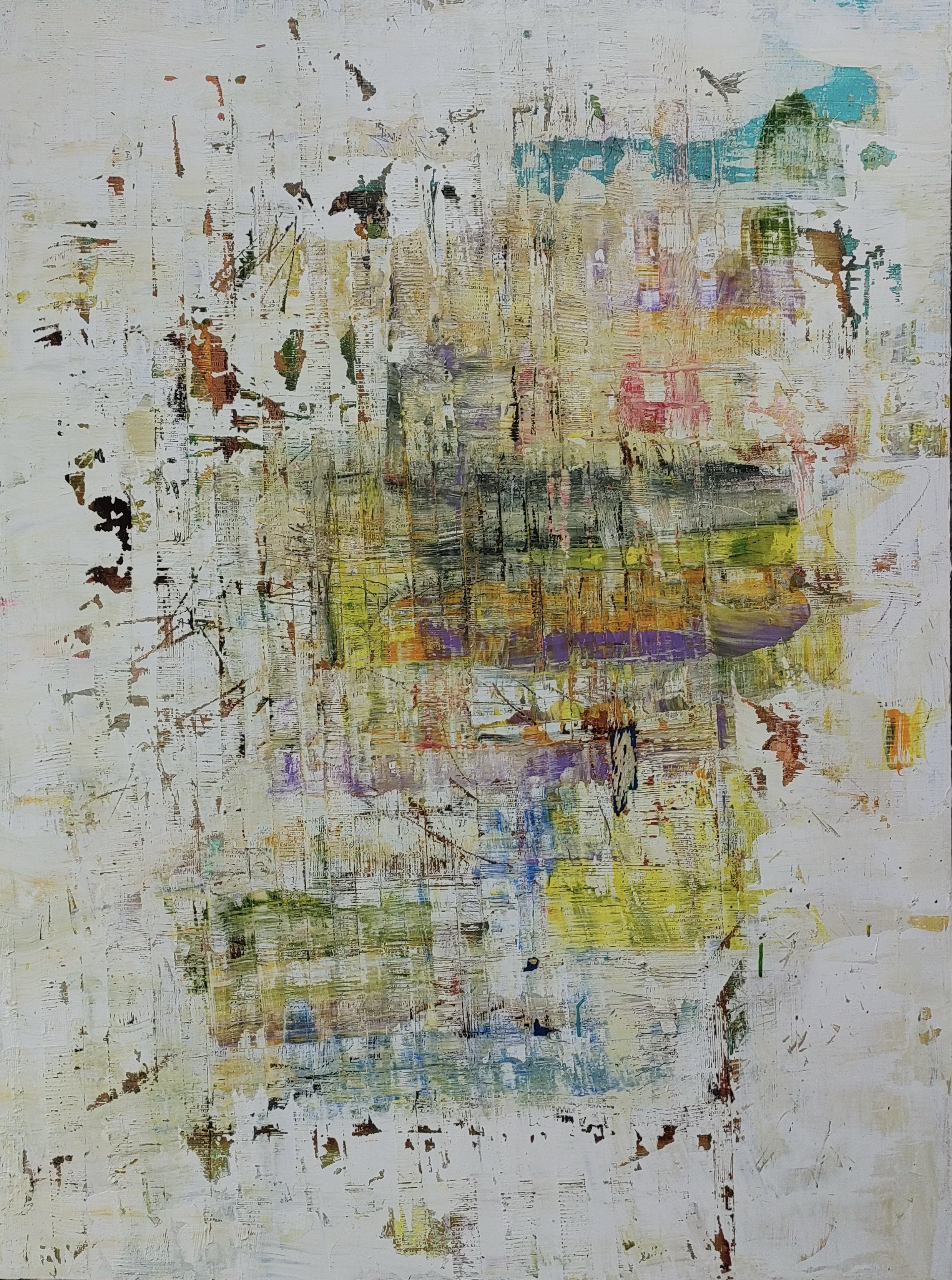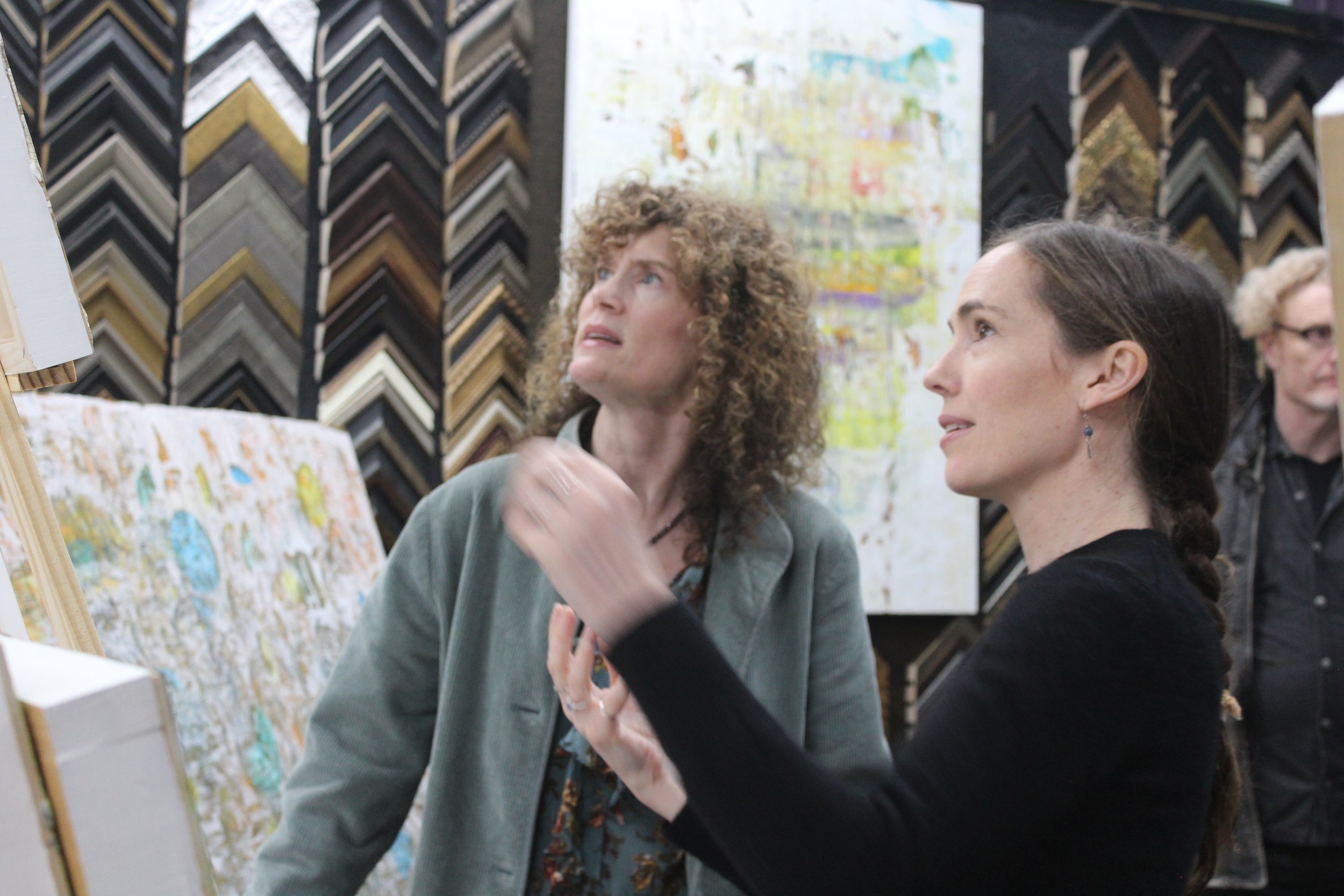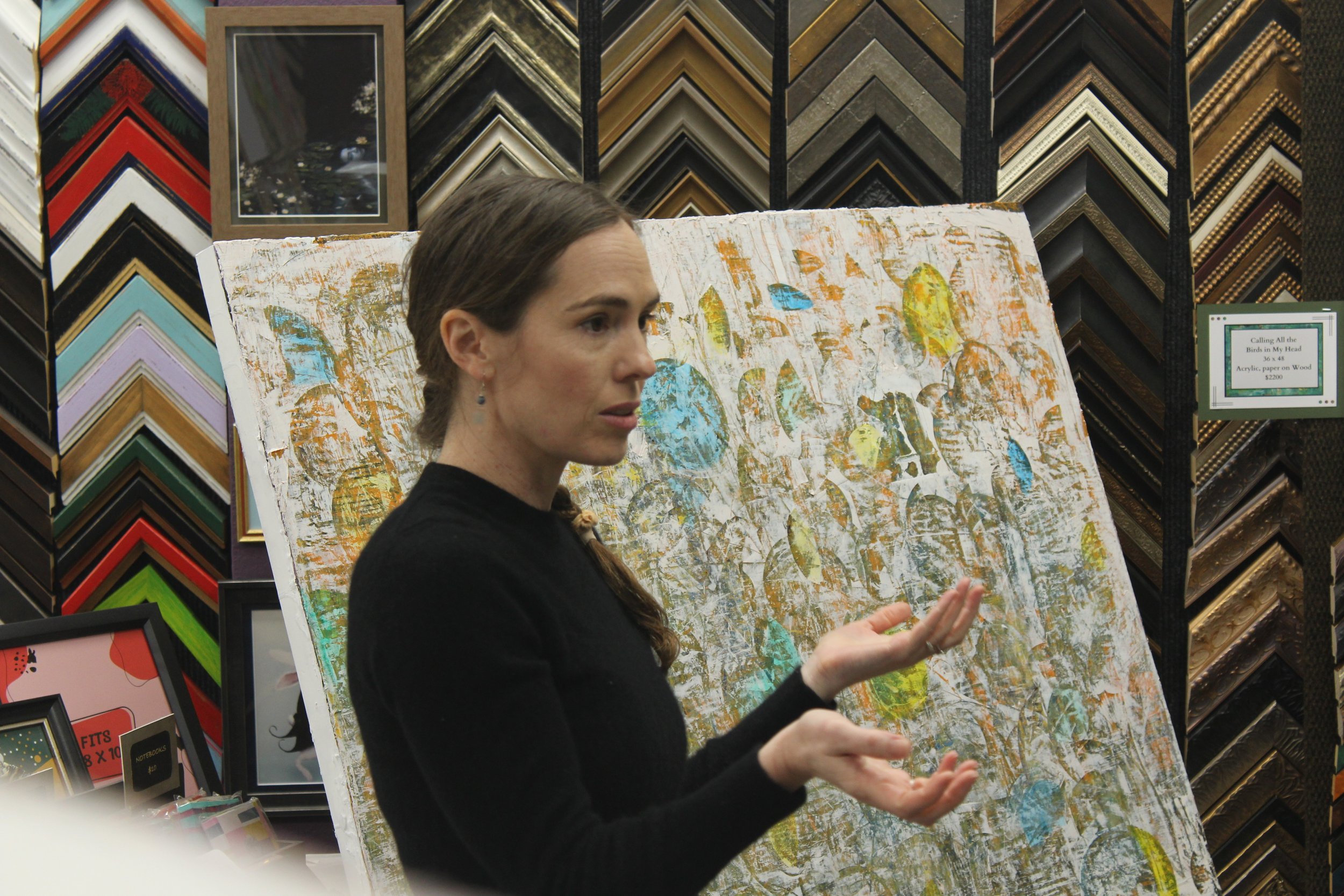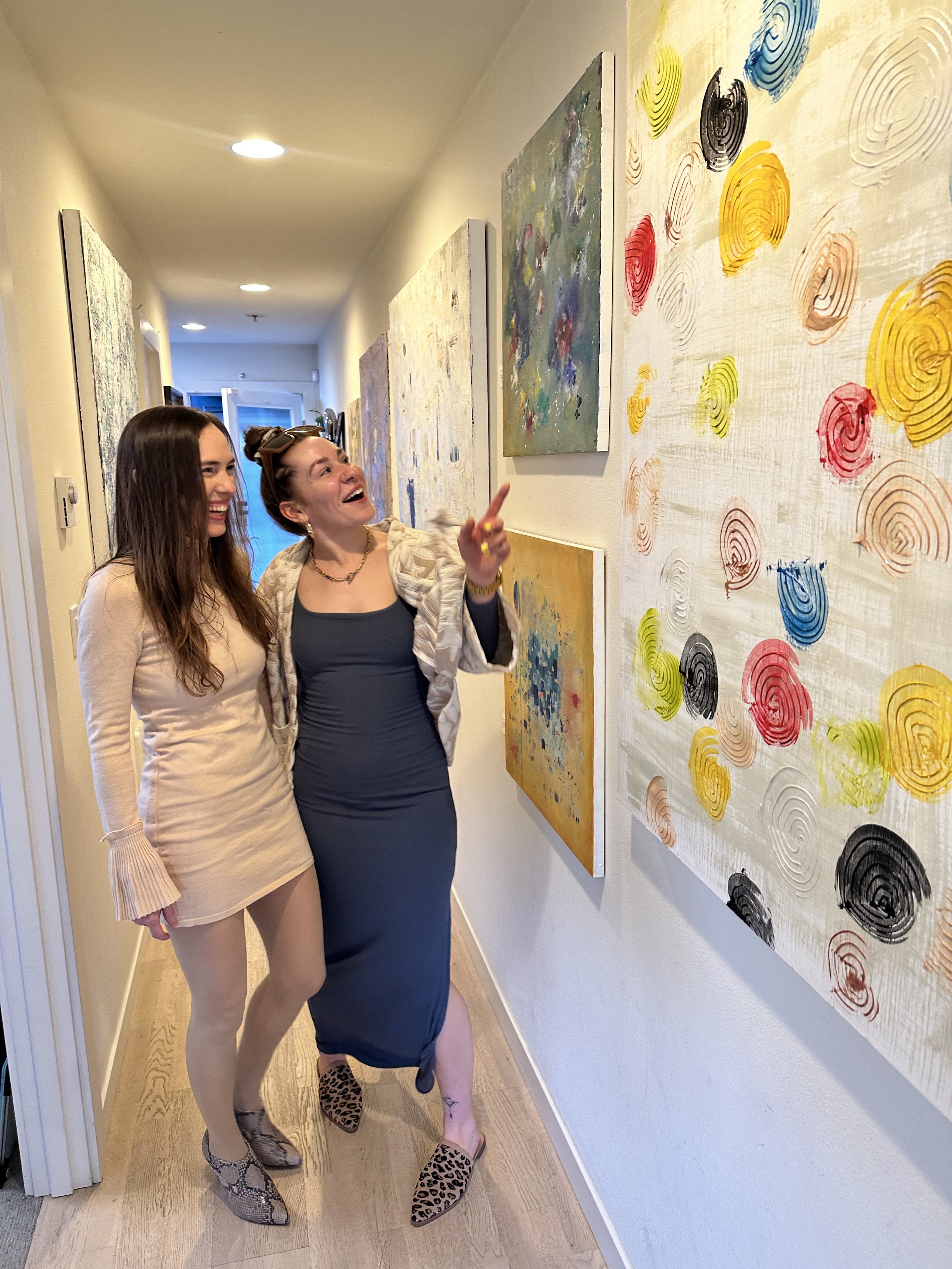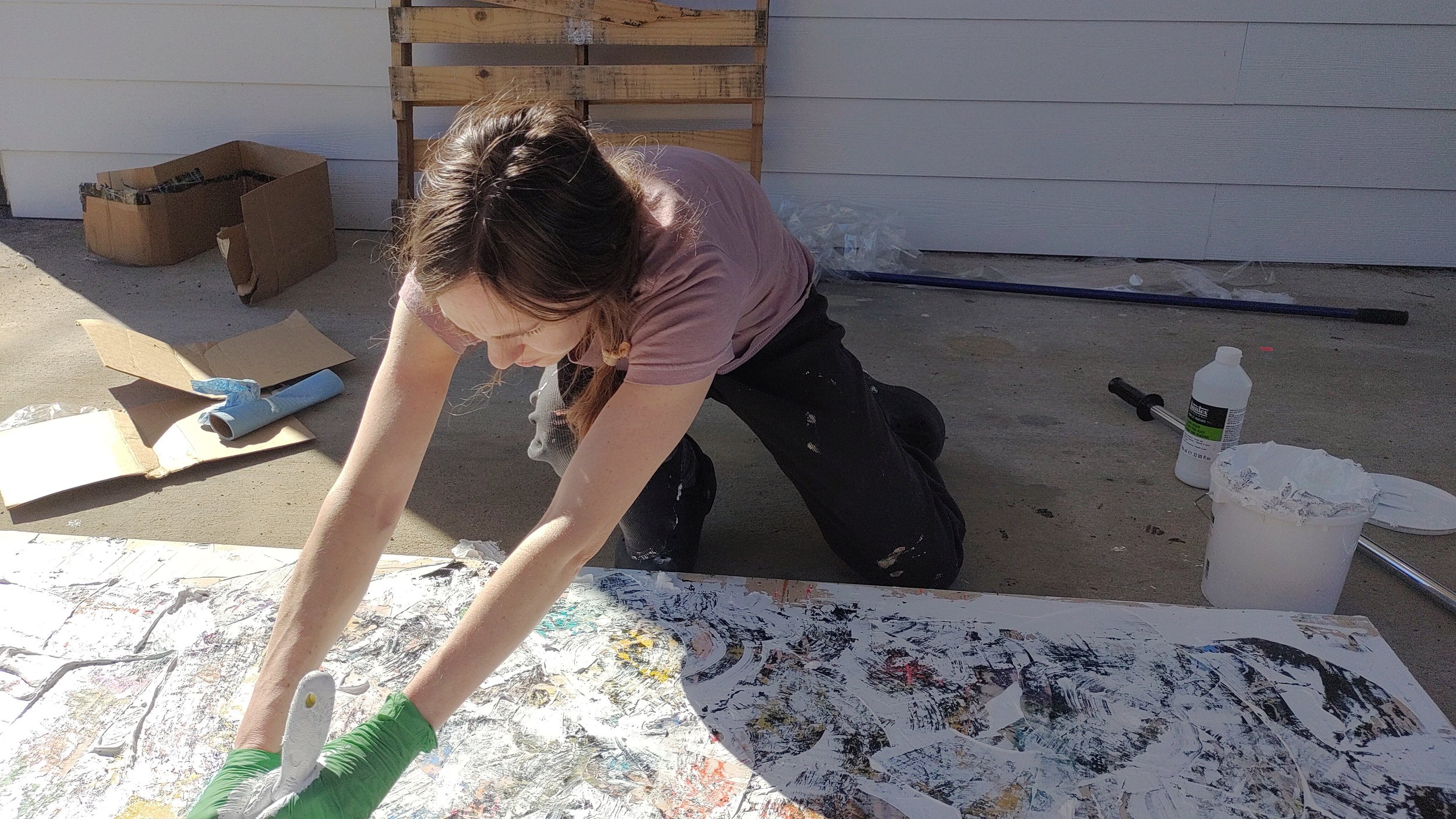Interview
Jennifer Leigh Harrison
Jennifer Leigh Harrison is a self-taught painter as well as a poet, psychotherapist and social worker based in Seattle. Her work as a whole largely focuses on themes of movement and deconstruction in lyrical abstract form. Her minimalist composition is distinguished by improvised layers of stripped surfaces that house texture, color, repetition, disruption, struggle as well as parody, whimsical, playful and imaginative moments. She uses her body and emotion as her primary tool to achieve what is more often than not an all body process that is more of an evolution than repetition of form. Her art is currently on display in and around Seattle.
What is your background and how did you start your journey in the art world?
“I'm a self-taught painter, and also a poet, social worker and psychotherapist. My mother is an artist who studied printmaking and taught art in public and private schools- I grew up with a lot of creative process around me but did not see it as my path. When I was young, my mother was on a mission to bring arts into the public school system during a time when a lot of kids did not have access. She was fierce in her commitment. In the creative womb of my mother's worldview, I do think the world of art and one's place as an artist begins at the time of consciousness; it is a world of cultivating and protecting imagination, curiosity and play that we slowly or quickly run risk of losing connection to. I think in many ways as adults we are trying to get back to that untethered experience of not having to meet demands or expectations of that around us.
On the contrary, my father is a hard working attorney and I think in that I inherited also a tough and driven inclination toward labor intensive work, which my process also entails. I try to break free from conformity and rules in my abstract expression in every way I can by staying out of my head and staying close to the energy between myself and the paint on the board. I think this is an essential part of being an outsider artist--that what comes out is not guided or pre-planned, but intuitive and authentic. My professional art began as a poet expressing myself through the rhythm, sound and image of words. I was writing poetry at 13 and was awarded a writing scholarship in college. In my twenties I became ill and for a period of time disabled and unable to walk-- I was in bed most days waiting for the treatment to work, uncertain if it would. There was no guarantee. During this time of uncertainty while life seemed to go on without me I painted on big warped pieces of plywood-- it was an impulsive need. I had a friend deliver the wood from the hardware store to my apartment and put it on the kitchen floor. I didn't even know why.
On days when the sun was out and I could sit on the floor, I would paint with my hands and feel energized, as if life was flowing back into me. The colors and movement became healing energy inside my body. I wrote a piano piece too, though I did not really write music seriously. I needed things to flow out and in as if I was catching my breath. In retrospect, I was keeping my spirit from dying. Once I was well again, my career as a psychotherapist took up much of my time and I did not paint again until I became once more ill in my early 40s. This was during Covid. I was hospitalized for a week and could not see loved ones for nearly a year. It was a dark and isolating time for many of us, my story was not unusual but I mostly moved through it quietly and with a lot of fear of how it would go. I was very sick. It was at this time I started painting seriously, as if my life depended on it. It was not even a mental connection of purpose, I just physically needed the outlet and process of painting of doing the labor and then having something I felt drawn to, something alive, reflecting back at me. I also fell in love around this time. The first time my partner visited I turned all my paintings over or put sheets on them and shut down any questions. Once, I did finally share one painting, then two, then three, I had the experience of someone seeing and really witnessing my work and being an artist himself, a composer, saying "no, this needs to be shared, this does not need to be kept to yourself." This reflection really broke me out of my cocoon - falling into the clumsy process of letting myself into the world in the way one is meant to be: Authenticated. Alive.”
What does your work aim to say? Does it comment on any current social or political issues?
“I relate to the use of the term lyrical abstraction as an opening of personal expression-- my work is emotional and the art wears its beauty and its scars in equal measure. I am an intuitive painter, and my work can be impulsive and shift according to what embodied state I wish to portray in a given moment. I enjoy the unbridled freedom of not following any constraints that would fog my creative expression. Because I do not usually complete a painting in one session, there are many "states" contained in one image that gives it depth and complexity. My paintings can seem disjointed when shown together if there is not the understanding that with emotional expression comes many different states: ones that are heavy and dark and intense, ones that are light and playful and whimsical. There is an element of capturing the spectrum of the human emotional experience through abstract imagery that captivates me.
I don't want to be tied down to one form or repetitive process, though I understand and appreciate that is a place of study and depth. I have many themes I'm working off of at a time and do repeated processes that morph into something undiscovered or new. My work does have something to say about the hidden, the revealed, what is pushed under and brought forward as a gift or admission or what is even clawed back to rescue or reclaim or stand as confession. Getting under the layers that have covered up the authentic frame of the being of the work, or pulling back oppressive heavy layers in a way that frees the image from its monotony. I struggle greatly with the restriction and limitation of my expression - to fully embody and translate that to image is an all body experience that can feel like literally running a marathon, which I can say I know what is like. It is definitely about giving up control, which houses an organic, messy look and feel. My work captures movement, dance, bodily expression, rhythm in thematic instances of oppression, liberation, struggle, play, overt expression. As an artist in my beginning of a new piece, I fall in love with the images in my head and settle for what I create, and then fall in love with its imperfections and place.”
Do you plan your work in advance, or is it improvisation?
“My painting is intuitive and improvisational. Any planning I do, goes out the window and is directed by moments of great alteration or change guided by feeling and physical embodied presence with the work. It can be very impulsive. I paint at home to live in my art, in its life form and alterations. I find this essential and very important to my process. I spend time sitting with it, walking by it when taking breaks from my day job. Color is moving, texture is moving. Almost all my painting is done on the floor at the level with the painting. This all body process and experience allows me to feel at one with a painting once I am in flow with it. It is like breathing, dancing, and all the other miracles that life grants us minute to minute.”
“My work is emotional and the art wears its beauty and its scars in equal measure.”
Are there any art world trends you are following?
“I do like street art as a commentary to the current times, particularly the rebellion and social response it holds in its unique territorial way, but also dates back to cave paintings - all little snapshots of time, markings of our place and reflection on it. It holds an element of edge-pushing and disruption or interruption that I like, even though it is not my style or inclination. I am interested in the abrupt or something that seems to have a pulse or a strong statement, as much as a subtle statement that you melt into the being of it and feel cradled in it. Things that shift the paradigm in the art world captivate me. I focused my graduate studies on themes of postmodernism in mental health and ways traditional frames or assumptions about psychological health or madness should be challenged or questioned. I feel very much the same regard about any art form: challenging the norms, disrupting the status quo, creating discomfort or incongruence in the artisinal womb. I can't say I'm achieving that, but I'd like to discover in myself my path for doing just that. One of the first times I walked away forever changed, and not really knowing how or why was in Madrid after viewing one of Goya's Black Paintings of Saturn Devouring His Son. I was 20 years old. Something goes deep in the crevices of your soul, merges with your own darkness, and also has the experience of "this too is acceptable art?" It was as if my own inner artist was slightly unleashed in this moment, and it proceeded to spill into my poetry. Jung said "First one has to take seriously the existence of the shadow" and I think in art one's work deepens when they settle into the crevices of themselves and let not just the light, but the dark make its presence known.”
What process, materials and techniques do you use to create your artwork?
“I work primarily with acrylic and acrylic mediums. I like to incorporate at times cold wax, encaustic, and oil, but this is more rare. I paint with my hands and with hard tools and usually not with paintbrushes. I use things like large scrapers, knives, rakes, floor squeegees, knives, electric sanders, wooden and silicone tools. I sometimes wish my boards were not pre-cradled so that I could literally walk and sit on them while I'm working on them. I love texture and the embodied practice of starting with a vibrant layer, then covering it up and stripping it back. This can be an intense process as often I am carving forcefully into layers to bring out what is hidden. I recycle a lot of my paint in the stripping process, putting it into tight lid containers and re-using it again and again gives the work a grit and feel that is unique.”
What does your art mean to you?
“My work is very messy, I get paint everywhere and now that I live with my partner I realize I am a bit too unapologetic about my mess. What is left is organic, worn, imperfect, much like the authentic self. It is mine and in that regard there is no deep need for it to have a purpose; in making it it has served its purpose. I feel deeply connected to my work, but don't expect others to have that same experience, but when they do, that is nice. I think it is true that if I could explain to you what my art means to me I would not have to create it in image - it is what is unsaid that I love so much. I'm a very introverted person and appreciate being able to communicate without words, which is funny to acknowledge as a poet, but points to the complexity of our unique selves in all their forms. I have been painting seriously now for 2+ years and just launched into the art scene in 2024 after building and launching a website to market my work in January of this year. It is March now and I have scheduled 6 solo shows up to June, which is a lot of work, pressure, and excitement. There is something precious about being in the infancy of my painting career: so much is unknown and from a place of inexperience. I just completed my first 7 foot painting. I feel I am protecting what my art means to me as I go through the vulnerability of exposure and people reflecting back what my work means to them. It is, generally speaking, a projection board and I often don't really want to comment on what that is about as emotions and states of consciousness are fleeting - how I feel about this one painting today is totally different another day and it holds the depth of having many stories, layers, understandings. There can be sadness underneath the happiest image and vice versa. This is not unlike the lyrical and abstract expression of my poetry. One experience I've had with viewers of my art is that two people can see my painting and have a polarized experience: one feels it is violent--the other feels it is light, playful. I love that. Both can be true and entangled in the form, and likely are, given that through the process of painting, I go through a myriad of feelings, impressions, movements that embody the human condition in messy and captivating ways.”
What’s your favourite artwork and why?
“I appreciate many artists of different modalities, especially those who have worked outside the context of their time or been outliers in the field of expression. I feel like they broke out of the confinement or expectation held in the frame. Marina Abramovic is one who pushed the edges of questioning the limits of the body and endurance art. In my own experience, I do feel I push the limits of my body through painting and expression and that I am at the infancy of doing so. I don't know if it will always be through painting or if it will emerge in other forms. The art of Butoh dance is another example. Japanese tradition originally did not accept Butoh in its culture. I am drawn to that form of expression because it is organic, deconstructed movement and is not necessarily always beautiful. Also, it addresses difficult topics.
Some of my paintings to me are truly ugly, deconstructed and they go into shows because I think they have a place in the world of expression - they belong with the pieces I think are pretty and easily digestible. They fill the spectrum. Although I am not a trained dancer, I took a drop-in ballet class a couple times in my adulthood and then a modern drop-in dance class because I find movement and body expression to be a very beautiful art form. One thing that struck me was the difference between myself as an untrained dancer and the ballerina who has trained since childhood. It is difficult to get outside the embodiment of that set of rules, that expectation, that rote form--once it has become a pattern, it is indoctrinated and cautioned against moving out of. Moving out of it creates discomfort, judgement, but also invites curiosity and at best an experience of cognitive dissonance that can become revolutionary to our existence here on earth. I constantly try and want to be on the outside of that pattern of expectation in whatever creative work I embody, as I do find organic movement and the path of the outsider artist such as myself as carrying its own untarnished wisdom and gift for the world of visual art.”
Have you had any noteworthy exhibitions you'd like to share?
“I have a big show coming up in May that will go through June of 2024 put on by Wonder Collective at the Labour Temple here in Seattle. My vision of it is great and exuberant to hold. Not because I have it planned out, but because I have that wide space to express, it feels rightly limitless in all the ways I want. I know artists that draw out in frames what they will produce, what the show will be, the specific timeline but that is not my process. Not having a scripted process leaves a lot of room for vulnerability, fear, uncertainty, all the elements that brought me to paint in the first place. I have to give in to what is there, even if it seems silly or absurd or not enough it is what is right here and what is here is the work to be done.”


